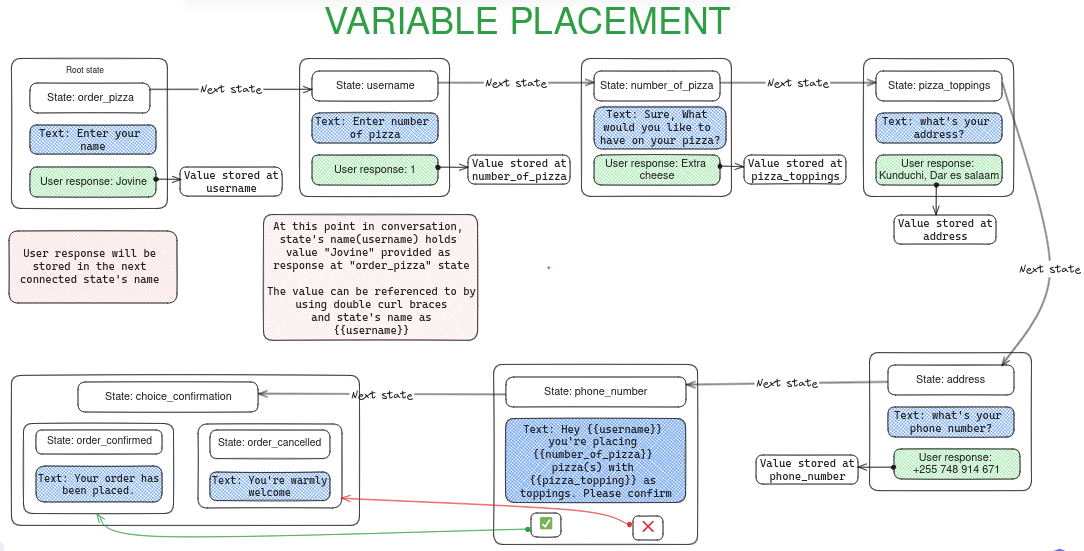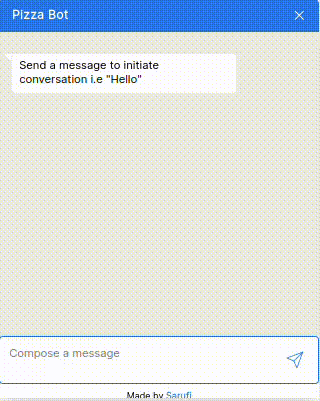Variable placement
Our chatbot has been growing in functionality. However, we could make it cooler by supercharging its conversation skills 💬. Imagine that our PizzaBot asks for a username and about what toppings the customer wants on their pizza. We can then use the responses to give a personalised message which confirms the delivery details to the customer.
More on variable placement
Lets have a look at the order_pizza flow below:

From the flow above, we can use the user's response from a previous state to provide a personalised response. Variable placement is implemented in the flow by enclosing the state name in double curly brackets, like {{state name}}. The same format is used in the Sarufi Dashboard. The variable should be only used within the same flow.
Implementing variable placement
We are going to update our PizzaBot to provide personalised answers. There are example YAML and JSON files below. After updating the flow, update your bot similarly to the previous guides.
Here is a diagram explaining how variable placement works:

The user response from the previous state is stored in the memory of the next state. So at state username, the bot has memory of the response provided in the previous state of order_pizza with the value Jovine. The value can be referenced in the message as {{username}}.
This can be done at any state in the same flow. The bot will let our customer know how many pizzas they have ordered and what toppings they selected.
Get started by updating the flow file. Feel free to use the dashboard as the created flow is the same.
- YAML
- JSON
order_pizza:
message:
- - 'Hello, what''s your name?'
- - Can you provide your name please?
images:
- link: >-
https://sarufi-media.s3.amazonaws.com/d265fce7-3f73-4a40-b03f-f68ddbee6ebc.jpg
caption: Welcome to PizzaBot
next_state: username
username:
message:
- '{{username}}, how many pizzas would you like to order?'
next_state: number_of_pizzas
validators:
- type: custom_validation
regex: '^[1-9]?$'
error_message: "\U0001F926\U0001F3FD♀️ Please provide a valid number between 1-9."
number_of_pizzas:
message:
- What toppings would you like to have on your pizza?
next_state: pizza_toppings
validators:
- type: custom_validation
regex: '^[a-zA-Z]+$'
error_message: "\U0001F926\U0001F3FE♀️ Please only enter text."
pizza_toppings:
message:
- - 'Hey {{username}}, what is your address?'
type: text
next_state: address
address:
message:
- '{{username}}, what is your phone number?'
type: text
next_state: phone_number
validators:
- type: phone_number_validation
error_message: >-
Please enter a valid phone number like 0711111111, +255711111111 or
+(222)222-2222.
phone_number:
message:
- >-
{{username}}, you're about to place an order of {{number_of_pizzas}}
pizza(s) with {{pizza_toppings}} to be delivered to {{address}}.
- ''
- Please confirm if this is correct.
- ''
next_state: choice_confirmation
type: interactive
buttons:
- '1': ✅ Confirm
- '2': ❌ Cancel
choice_confirmation:
'1': order_confirmed
'2': order_cancelled
fallback_message:
- Please select 1 to confirm or 2 to cancel
order_cancelled:
message:
- 'See you next time!'
- ''
- We are always happy to serve you.
type: text
next_state: end
order_confirmed:
message:
- Thank you for ordering with us. Your order has been placed.
type: text
next_state: end
{
"order_pizza": {
"message": [
["Hello, what's your name?"],
["Can you provide your name please?"]
],
"images": [
{
"link": "https://sarufi-media.s3.amazonaws.com/d265fce7-3f73-4a40-b03f-f68ddbee6ebc.jpg",
"caption": "welcome to PizzaBot"
}
],
"next_state": "username"
},
"username": {
"message": ["{{username}}, how many pizzas would you like to order?"],
"next_state": "number_of_pizzas",
"validators": [
{
"type": "custom_validation",
"regex": "^[1-9]?$",
"error_message": "🤦🏽♀️ Please provide a valid number between 1-9."
}
]
},
"number_of_pizzas": {
"message": ["what would you like to have on your pizza"],
"next_state": "pizza_toppings",
"validators": [
{
"type": "custom_validation",
"regex": "^[a-zA-Z]+$",
"error_message": "🤦🏾♀️ Please only provide text."
}
]
},
"pizza_toppings": {
"message": [
["Hey {{username}}, what is your address?"],
],
"type": "text",
"next_state": "address"
},
"address": {
"message": ["{{username}}, what is your phone number?"],
"type": "text",
"next_state": "phone_number",
"validators": [
{
"type": "phone_number_validation",
"error_message": "Please enter a valid phone number like 0711111111, +255711111111 or +(222)222-2222."
}
]
},
"phone_number": {
"message": [
"{{username}}, you're about to place an order of {{number_of_pizzas}}
pizza(s) with {{pizza_toppings}} to be delivered to {{address}}.",
"",
"Please confirm if this is correct.",
""
],
"next_state": "choice_confirmation",
"type": "interactive",
"buttons": [
{
"1": "✅ Confirm"
},
{
"2": "❌ cancel"
}
]
},
"choice_confirmation": {
"1": "order_confirmed",
"2": "order_cancelled",
"fallback_message": ["Please select 1 to confirm or 2 to cancel"]
},
"order_cancelled": {
"message": [
"See you next time!",
"",
"We are always happy to serve you."
],
"type": "text",
"next_state": "end"
},
"order_confirmed": {
"message": ["Thank you for ordering with us. Your order has been placed."],
"type": "text",
"next_state": "end"
}
}
At the order_pizza state, the customer will enter the number of pizzas they want to order. This response is stored in the memory of the next state. So at state number_of_pizzas, our bot has a memory of the response provided in previous state of order_pizza.
The same happens at the pizza_toppings state where the response from previous state, number_of_pizzas is in the memory at that state.
This can be done at any state in the same flow. The bot will let our customer know how many pizzas and what toppings they have ordered.
In the flow used you can notice that we used choices. If do not fully understand choices, please read the guide about choices here.
Results
Here is what the bot response looks like. This bot uses the flows shown above.

You can see how this feature can be used to provide a personalised experience to your customers.